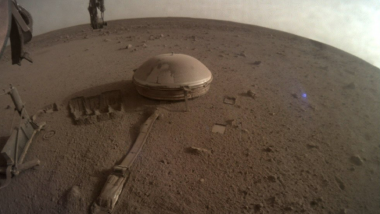New Delhi, December 20 : NASA's Mars InSight lander on Tuesday posted its last image on Twitter as it prepares to fall silent anytime, ending its history-making mission to reveal secrets of the Red Planet's interior. The spacecraft's power generation continues to decline as windblown dust on its solar panels thickens. The end is expected to come anytime. NASA Sensors To Help Scientists Detect Methane Emitted by Landfills Across the Globe.
"My power's really low, so this may be the last image I can send. Don't worry about me though: my time here has been both productive and serene. If I can keep talking to my mission team, I will - but I'll be signing off here soon. Thanks for staying with me," posted the InSight lander team.
The 30-member odd operations team - a small group compared to other Mars missions - continues to squeeze the most they can out of InSight (short for Interior Exploration using Seismic Investigations, Geodesy and Heat Transport). The most important of the final steps with the InSight mission is storing its trove of data and making it accessible to researchers around the world.
The lander data has yielded details about Mars' interior layers, its liquid core, the surprisingly variable remnants beneath the surface of its mostly extinct magnetic field, weather on this part of Mars, and lots of quake activity, according to NASA. Nine Jammu and Kashmir Students Participate in Global Asteroid Search Campaign as Part of NASA Project.
InSight's seismometer has detected more than 1,300 marsquakes since the lander touched down in November 2018, the largest measuring a magnitude 5. It even recorded quakes from meteoroid impacts.
"Finally, we can see Mars as a planet with layers, with different thicknesses, compositions," said Bruce Banerdt of NASA's Jet Propulsion Laboratory in Southern California, the mission's principal investigator.
"We're starting to really tease out the details. Now it's not just this enigma; it's actually a living, breathing planet." The seismometer readings will join the only other sets of extraterrestrial seismic data, from the Apollo lunar missions and the Viking Mars missions, in NASA's Planetary Data System.
They will also go into an international archive run by the Incorporated Research Institutions for Seismology, which houses "all the terrestrial seismic network data locations", said JPL's Sue Smrekar, InSight's deputy principal investigator. "Now, we also have one on Mars."
Smrekar said the data is expected to continue yielding discoveries for decades. There will be no heroic measures to re-establish contact with InSight. While a mission-saving event - a strong gust of wind, say, that cleans the panels off - isn't out of the question, it is considered unlikely.
(The above story first appeared on LatestLY on Dec 20, 2022 08:06 PM IST. For more news and updates on politics, world, sports, entertainment and lifestyle, log on to our website latestly.com).













 Quickly
Quickly




















